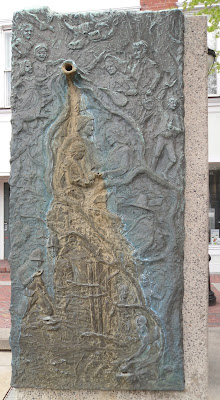Emily A. Murphy's Nathaniel Hawthorne's Salem: A Walking Tour of Literary Salem in the Early Nineteenth Century (Salem, MA: National Park Service/Salem National Historic Site, 2007) is an invaluable guide. The post below contains what I consider to be the most interesting features in it, and most of the time I've summarized Murphy's comments under my own photos.
In 1808 Captain Hathorne died of yellow fever in Surinam. Elizabeth moved with her children - Nathaniel and his two sisters Elizabeth and Louisa - back to the home of her childhood at 10½-12 Herbert Street, the Manning House. Nathaniel moved from there for four years while attending Bowdoin College, and another four years when his family moved to North Salem, but apart from that this is where he lived between 1808 and 1840. Many of his early stories were written here, the place he term 'Castle Dismal'.
The Brown Building on the corner of Union and Essex streets, where Dr Nathaniel Peabody and his wife moved in 1810 with their daughters Elizabeth Palmer, Mary, and Sophia, who was one year old. The eldest daughter remembered seeing 'a little boy with clustering locks' playing in the nearby Manning garden, and many years later she would be his sister-in-law:
'Sophia Peabody Hawthorne
1809-1871
artist, journalist
travel writer, and
wife of
Salem's famous author
Nathaniel Hawthorne,
lived here in the
Brown Building
during her
early childhood.'
Before this, though, Nathaniel and his younger sister Louisa often went to a house in Turner Street that originally belonged to the Turner family, but which their cousin Susan Ingersoll had inherited. Three of the gables of this house had been removed, and Susan is said to have shown Hawthorne the missing gable marks in the attic. Hence the inspiration for Hawthorne's major novel, The House of the Seven Gables (1851).
But to return to Hawthorne's interest in graveyards which I mentioned here, right next to the Peabodys' home was Old Burying Point Cemetery, where a number of Hathornes lay. Hawthorne was most interested in the gravestone of his great-great-grandfather, Colonel John Hathorne, who was a judge during the Salem witch trials. It is unknown if this connection is the reason why Hawthorne added the 'w' to his name.
Another of the graves that interested Hawthorne was that of Cotton Mather's younger brother Nathaniel, who died at the age of 19. Toward the end of his first novel - Fanshawe (1828) - Hawthorne writes:
'[Fanshawe's] passage [to the grave] was consequently rapid, terminating just as he reached his twentieth year. His fellow-students erected to his memory a monument of rough-hewn granite, with a white marble slab for the inscription. This was borrowed from the grave of Nathanael Mather, whom, in his almost insane eagerness for knowledge, and in his early death, Fanshawe resembled.'
The full text of Fanshawe is here.
Hawthorne was nominated Surveyor of the Port of Salem by friends in the Democratic Party, a post he would retain for a little under four years. He was dismissed after the Whig Zachary Taylor was elected president, and a vicious smear campaign began against Hawthorne. As Hawthorne had (on the orders of Washington) written (but not delivered) letters of dismissal for inspectors who hadn't contributed to the Democratic party, and as he had given more work to Democrats, his fate was inevitable.
'SALEM TOWN PUMP FOUNTAIN
'THIS IS THE SITE OF THE
ORIGINAL SALEM SPRING,
LATER THE LOCATION FOR
THE TOWN PUMP
IMMORTALIZED BY
NATHANIEL HAWTHORNE
IN HIS FIRST BOOK
"TWICE TOLD TALES."
THIS FOUNTAIN IS HERE
THIS FOUNTAIN IS HERE
AT THE SUGGESTION OF
THE TOWN PUMP ITSELF,
IN "A RILL FROM
THE TOWN PUMP."
The town pump's words:
"And when I shall have decayed likemy predecessors, then, if you revere my memory, let a marble fountain richly sculptured take my place upon this spot. Such monuments should be erected everywhere and inscribed with the names of the distinguished champions of my cause.'
First book? What of Fanshawe? Well, Hawthorne paid for the publication himself, but later disowned it, and his widow Sophia denied its existence too despite all evidence to the contrary, so it seems that the pump is speaking with Hawthorne's voice too.
A close-up of the impressive work.
And on Hawthorne Boulevard is a large statue of the man.
This was sculpted in 1916 by Bela Pratt, who also sculpted the William Everett Hale statue in the Public Garden in Boston.























No comments:
Post a Comment